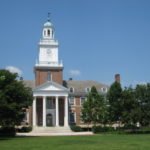Campus Life When Attending the United States Naval Academy
This article was written based on the information and opinions presented by Steven Frazier, an Admissions Counselor at the USNA, in a CollegeVine livestream. You can watch the full livestream for more info.
What’s Covered:
The United States Naval Academy (USNA) is a military university located in Annapolis, Maryland, about 25 miles outside of both Baltimore and Washington, D.C. If you’re applying to the USNA, you’re probably curious about what it would be like to attend. This article will explore what life is like as a USNA student.
USNA Amenities
Students who attend any of the service academies in the U.S. receive full scholarships. This means tuition, room and board, medical and dental insurance, and food are paid for while you’re at school, and you’re paid on a monthly basis.
The campus at the USNA is called “The Yard,” and it essentially has everything students need, from stores where you can buy groceries and clothing to a barber and cobbler shop.
The academy also has 22 world-class athletic facilities. The USNA is an NCAA Division I school, which means all of those facilities adhere to NCAA standards. Most of the facilities on campus are available for all students to use, not just school athletes.
Military Service
Even more than at a traditional college, at the USNA, it’s not just about the four years students spend there―it’s about the next 40. The academy is a very competitive school. It’s also quite different from other four-year colleges because, once students graduate, they commission as officers in the Navy or Marine Corps.
If you attend the USNA, you do have to serve five years in the military following graduation, so it’s very important to consider what you’re looking for from a college experience and what you may be interested in after you finish your studies. The academy gives students plenty of opportunities to explore these questions, but prospective students should keep that additional commitment in mind when considering the USNA.
Curriculum
In terms of available majors and minors, the academy is very focused on the STEM (science, technology, engineering, and math) fields. Students also have the opportunity to earn a minor in one of several foreign languages, no matter their major.
Every student is required to complete the Core Curriculum while in the brigade at the USNA. Most of these classes will be completed during the early years at the academy. These core courses encompass leadership and professional development, math and science, humanities, and social sciences.
The academy has relatively small class sizes compared to many other colleges. Class size ranges between 10 and 25 students, allowing close contact with faculty. There is a roughly 50-50 split between active duty instructors and tenured professors, so there is a rich range of backgrounds and life experiences that you can learn from your teachers. In addition, about 75% of the student body participates in some international experience during their time at the USNA.
Student Life
The USNA has about 4,500 total students from a diverse set of backgrounds and locations. Students attend from all across the U.S., all of its territories, and several foreign countries. As a student at the USNA, you will meet people from all walks of life.
All students live in Bancroft Hall, which is the dorm building located on The Yard. Students develop a real sense of closeness and community, almost becoming an extended family.
Mornings begin with personal conditioning, a workout that students participate in with their companies. This is followed by formation, breakfast, then the first four classes of the day. The schedule is similar to that of a high school, and some academic periods may be doubled up, such as a science lab that lasts for two periods.
Students have 90 minutes for lunch, then attend their last two classes of the day before the athletic period (everyone at the USNA is involved with athletics in some form). This is followed by formation, dinner, and, finally, an academic study period from 8 p.m. to 11 p.m. There’s no requirement to only study during this time, and students certainly don’t have to study for the entire three-hour period. This is more of an opportunity to have uninterrupted time to focus on your priorities.
That may seem like a packed schedule, but students find time for extracurricular activities as well. There are tons of opportunities to engage with others on campus, spanning every subject from music to religion.
If you are interested in learning more about other military colleges in the United States, check out this article: Guide to Military Colleges: Should You Attend One?



